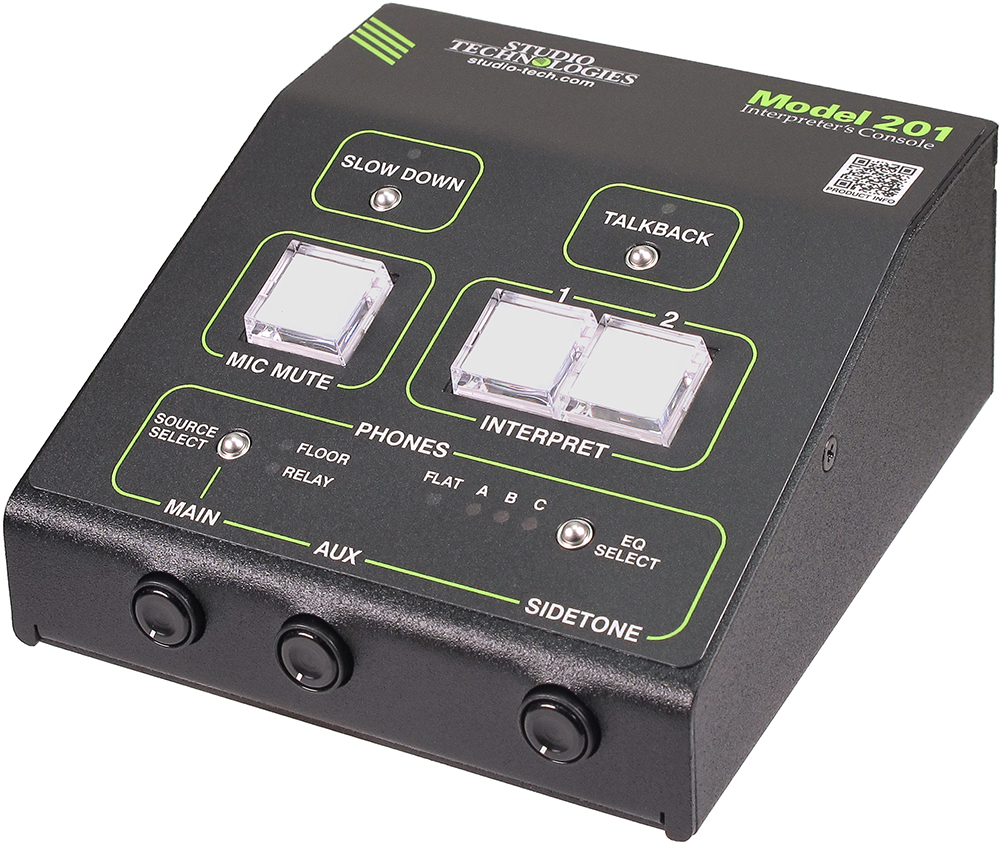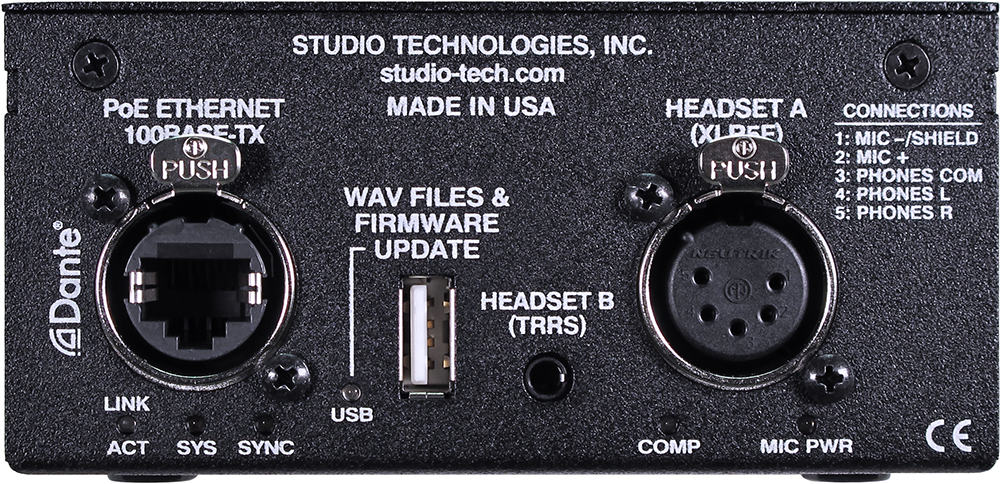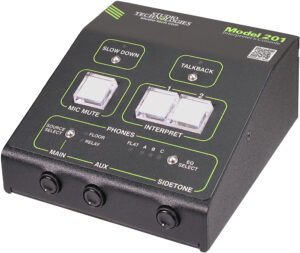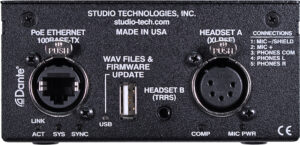The Model 201 Interpreter's Console is a complete solution for supporting applications that utilize specialized personnel who perform simultaneous language interpretation. Suitable for use in single- or multi-language situations, the Dante® audio-over-Ethernet-enabled unit includes a range of features not typically provided by "off-the-shelf" interpretation equipment. The Model 201 provides both the standard and advanced features required for successful deployment in local and off-site/remote applications.
The Model 201 includes the ability to create two independent interpretation audio channels. Configuration choices allow a variety of audio content to be included in the interpretation audio; content that can be automatically muted or dimmed (reduced in level) when interpretation is active. This is especially important for off-site or Internet streaming applications. A dual-channel (stereo) headphone output can be configured to meet the needs of the interpreter. This includes selecting the audio sources, channel routing, and sidetone (confidence) signal operation. A set of pushbutton switches and rotary controls allow the user to establish the operating condition they desire.
A "mic mute" pushbutton switch allows the connected microphone to be momentarily muted.
The frequency response of the headphone output can be selected from four equalization (EQ) settings. A talkback function allows a separate audio path to be established from the interpreter to production personnel. A slow down function allows the interpreter to signal to the presenter (the "floor" source) that speaking more slowly is warranted.
The Model 201 is extremely simple to deploy, is "pro" quality throughout, and provides an intuitive user experience. The unit's audio quality is excellent, with low distortion, low noise, and ample headroom. Careful circuit design and rugged components ensure long, reliable operation. Only a Power-over-Ethernet (PoE) connection and a headset with attached microphone is required for operation. The Model 201 supports both professional intercom-style headsets that use a 5-pin XLR connector as well as "gaming" headsets that use a 4-conductor 3.5 mm TRRS plug. If desired, two "custom" WAV audio files can be loaded by way of a USB flash drive. These can be used for aural confirmation of the Model 201's two interpretation audio channels.
The Model 201 supports Dante audio-over-Ethernet digital media technology for integration into contemporary applications. In addition to supporting standard Dante, the unit is compatible with AES67 and the Dante Domain Manager™ (DDM) software application. Only a single 4-pair Ethernet cable is needed to support both bi-direction data and Model 201 DC power.
The Model 201's operating features are configured using the STcontroller software application. An extensive set of parameters allows the unit's functions to be tailored to meet the needs of a range of interpretation applications. The Model 201 is housed in a compact but rugged steel enclosure that's intended for table-top use. Its small size makes it ideal for applications in space-constrained locations.
While the Model 201 can be used by itself to create a simple, 1- or 2-language interpretation position, it can easily become part of a multi-language, feature-rich application. By utilizing Dante technology, one or more Model 201 units can integrate with other Studio Technologies' products to achieve a sophisticated voice interpretation system. Applicable companion units include the Model 391 Dante Alerting Unit, Model 5205 Mic/Line to Dante Interface, Model 5412 Audio Interface, and Model 5421 Dante Intercom Audio Engine. Other Dante-compliant products, such as audio consoles or wireless microphone systems from other manufacturers, will also directly interface with the Model 201.
Headphone Output Channels
The Model 201 provides a 2-channel (stereo) output that is routed to both the 5-pin female XLR and 4-conductor 3.5 mm TRRS headset interface connectors. A pushbutton switch and three rotary controls on the unit's front panel allow users to select their desired headphone audio sources and adjust the signal levels. The pushbutton switch and two associated LED indicators allow direct selection of either the Floor or Relay Dante receiver (input) audio channels. Floor is the term in the interpretation world for the audio channel associated with the person whose spoken text is to be interpreted. It may also be considered to be the "original" audio source. Relay is the term used for an intermediate audio signal that would typically be supplied by another interpreter. (A "relay" language is usually selected as an interpretation technique to support multiple languages. For example, English might be selected as the relay language.) The selected audio signal, Floor or Relay, is referred to by the Model 201 as the Main audio source. It can be sent to the left only, right only, or both the left and right headphone output channels. A rotary control allows the level of the Main audio signal to be adjusted.
Two additional Dante receiver (input) audio channels, named Aux 1 and Aux 2, can be used to interface the Model 201 with signal sources such as audio consoles, media playback systems, or remotely located equipment. A rotary level control is used to adjust the level of both Aux 1 and Aux 2 as they are sent to the headphone output channels. Configuration choices in the STcontroller application allow the Aux 1 and Aux 2 signals to be independently routed to the left, right, or left and right headphone output channels. This allows a variety of signal sources to be effectively routed to the desired headphone outputs.
A separate rotary control is used to adjust the level of the Model 201's microphone preamplifier signal as it is sent to the headphone output. This is called the sidetone function and provides the interpreter with a confirmation audio signal. A configuration choice in the STcontroller application is used to select the routing of the sidetone audio as it is sent to the left and/or right headphone output channels. It can also be disabled.
A pushbutton switch, also located on the unit's front panel, allows selection of the desired headphone audio frequency response. This is called the headphone EQ. Four LED indicators display the currently selected setting. Unlike most interpreter console products that provide analog rotary "tone" controls, the Model 201's headphone equalization functions are created within the digital domain. This has the advantage of being very "unit-to-unit" accurate, allowing, for example, EQ selection B on one Model 201 to be identical to EQ selection B on all other Model 201 units. Note that EQ (equalization) is applied to all selected headphone signal sources except sidetone which always remains "flat."
The headphone output channels can be selected to operate from among four frequency response choices: flat and three EQ (equalized or modified response) settings. Flat provides an unmodified version of the selected audio signals as they are sent to the headphone output channels. The three EQ selections cause low-frequency and high-frequency content to be removed from the headphone output channels. They also provide a boost (increase) to the mid-band frequency content. The choices of A, B, and C offer different EQ characteristics; B being more aggressive than A and C being more aggressive than B. These four choices will allow an interpreter to optimize the headphone output signal to best support their work.
Interpret Channels
The Model 201 provides two Dante transmitter (output) channels that are intended for use in interpretation applications. This allows a Model 201 to support one or two independent languages or audio paths. Two pushbutton switches, one associated with each interpret channel, operate in a latching (push on/push off) manner. LED status indicators within the switches display the current status of the interpret channels. When an interpret channel is active an 18 kHz sine wave tone can also be added (summed) with the microphone signal. This is provided especially for remote applications that require an indication ("tally") that an interpretation function is active.
The STcontroller application allows selection of the pushbutton switch color and whether a button is lit when the function is off. In addition, a configuration selection determines if only one, or both, of the interpretation output channels can be active at any one time. A separate pushbutton switch on the Model 201's front panel allows momentary muting of the microphone signal when an interpret channel is active. This provides a "cough" function for the interpreter, allowing them to temporarily mute their microphone signal as needed.
One or two audio sources can be assigned to each interpret channel. These are called the feedthrough sources and can be independently selected for each channel from the choices of Floor, Relay, Aux 1, or Aux 2. The choice of None is also available. When an interpret channel is not active (the connected microphone is not actively being routed to an interpret channel) the selected audio source(s) will be "fed through" to the interpret Dante transmitter (output) channel. When the interpret channel is active (the connected microphone is routed to an interpret channel) an STcontroller configuration selection determines what happens to the feedthrough audio sources. They can remain at full level, be muted, or be reduced (dimmed) in level by a fix amount. This set of resources allows the interpret channels to be configured for local use or to meet the needs required by a variety of streaming and broadcast applications.
Experienced users may recognize the feedthrough function as being essentially the same as a broadcast IFB (interrupted foldback or talent cue) function. This can be important for contemporary interpretation applications but is normally not provided by interpretation equipment.
A VOX (voice operated) function allows the one or two feedthrough sources to be attenuated or muted in response to an interpret audio source being present. Also, a switch configuration allows implementation of a 2-channel (stereo) interpret function. This can be especially useful in streaming applications where the feedthrough source consists of two discrete channels, typically a 2-channel (stereo) audio pair.
Talkback
The Model 201 provides a talkback function, allowing an interpreter to easily communicate with local or remotely located production personnel. On the unit's front panel is a pushbutton switch and LED indicator dedicated to the talkback function. An independent Dante transmitter (output) audio channel is provided for the talkback function. This signal can be routed (subscribed) to the Dante input on an amplified speaker, an audio console, or even to equipment at a remote location. Whenever the talkback function is active, microphone audio is not routed to either of the interpret Dante transmitter (output) channels.
The STcontroller application allows the operation of the talkback function to be configured to meet the needs of many applications. The function can be disabled (off) as well as selected for one of four operating modes. The pushbutton switch can operate in a momentary or latching (push on/push off) manner along with the ability to add an 18 kHz sine wave tone in addition to the microphone signal. This tone would be appropriate when the Model 201 is used in a distributed networked audio environment where both talkback audio and a talkback function active indication (tally) is warranted.
Slow Down Function
On the Model 201's front panel are a pushbutton switch and associated status LED that are utilized by the slow down function. This function is provided such that an interpreter can alert the event speaker (the person being interpreted) to speak more slowly and allow the interpreter to catch up with the speaker's voice content. Technically, when the Model 201's slow down function is activated, a high-frequency (18 kHz) sine wave tone is sent out a Dante transmitter (output) channel. This Dante output channel would typically be routed to the receiver (input) channel on a Dante-enabled device, such as a Studio Technologies' Model 391 Dante Alerting Unit or a Model 392 Visual Indicator Unit. The high-frequency signal can activate the designated device and provide the event speaker with a slow down indication. The Model 391 or Model 392 would typically be located at the event speaker's lectern where its visual indicator could be readily observed. A configuration choice within the STcontroller application allows the Model 201's slow down function to be active for 1, 2, 3, 4, or 5 seconds after the slow down pushbutton switch is momentarily pressed. A selection also allows the function to be disabled.
The term slow down can at first view be misleading. The slow down function actually requires a system implementation, consisting of a Model 201, a Dante network, and a means of displaying a slow down request. Activating the Model 201's slow down function simply provides an 18 kHz sine wave tone on the slow down/hot mic Dante transmitter (output) channel. This Dante channel would be subscribed (routed) to a Dante receiver (input) on a display device such as the Studio Technologies' Models 391 or 392.
Hot Mic Output
A special microphone output function is provided for use in installer-implemented applications. Called the hot mic output, it can be configured from among four choices. One choice provides a traditional "hot mic" output with its source being the output of the microphone preamplifier. Microphone audio is always present on a Dante transmitter (output) channel with no user action preventing it from being provided. Two other choices allow the microphone audio signal to be present when an interpret channel is enabled. The hot mic audio signal shares the same Dante transmitter (output) channel that is used for the slow down function. The function can also be disabled.
Confirmation Messages
An application may benefit from utilizing the Model 201's ability to store and playback WAV audio files. Two audio files, each up to 40 seconds in length, can be created in the high-quality 16-bit monaural WAV format and then loaded into a Model 201 using a standard USB flash drive. It's expected that these confirmation messages will provide identification information regarding the specific interpretation channels. This can prove useful during system setup and operation. They can be especially helpful when multiple Model 201 units are utilized in a single application. The ability to provide a unique aural confirmation signal for each channel may be extremely helpful to production personnel. For example, by using the confirmation messages the operator of an audio console could readily identify specific interpretation channels and confirm that they are ready for use.
The on/off status of each confirmation message is controlled using either a front-panel pushbutton switch-press sequence or the STcontroller application. When enabled, a confirmation message will play continually, repeating each time the end of the file is reached. The confirmation messages can find use locally and in remote interpretation applications, ensuring that the correct interpretation audio signal is being provided. No longer will "silent" audio channels be designated for interpretation, with technical personnel hoping that they will function correctly when they become active.
Setup and Operation
Setting up, configuring, and operating a Model 201 is simple. An RJ45 jack is used to interconnect a unit with a twisted-pair Ethernet port associated with a PoE-enabled network switch. This connection provides both bidirectional digital audio and power. A dual-channel or single-channel (dual- or single-ear) headset can be connected using a cable-mounted 5-pin male XLR connector. Alternately, a gaming or computer headset with a 4-conductor 3.5 mm TRRS plug can be used.
One or two "custom" audio files can be created and loaded into the Model 201. They utilize the common WAV file format supported by many personal computer applications. The STcontroller software application is used to configure the wide range of Model 201 operating parameters. This allows the unit's performance to be optimized to meet the needs of specific applications.
The user is presented with seven pushbutton switches and three push-in/push-out rotary potentiometers. All user controls are clearly labeled and simple to operate. LEDs provide status indications of the Model 201's various functions.
Ethernet Data and PoE
The Model 201 connects to a local area network (LAN) by way of a 100 Mb/s twisted-pair Ethernet interface. The unit's physical 100BASE-TX interconnection is made by way of a Neutrik® etherCON® RJ45 jack. While compatible with standard RJ45 plugs, an etherCON CAT5-compatible plug allows a ruggedized and locking interconnection for harsh or high-reliability environments. The Model 201's operating power is provided by way of the Ethernet interface using the 802.3af Power-over-Ethernet (PoE) standard. This allows fast and efficient interconnection with the associated data network. To support PoE power management, the Model 201's PoE interface enumerates (reports) to the associated power sourcing equipment (PSE) that it's a class 1 (very low power) device.
Dante Audio-over-Ethernet
Audio data is sent to and received from the Model 201 using the Dante audio-over-Ethernet media networking technology. As a Dante-compliant device, the Model 201's four Dante transmitter (output) channels and four Dante receiver (input) channels can be assigned (routed or subscribed) to other devices using the Dante Controller software application. The Dante transmitter (output) and receiver (input) channels are limited to supporting four Dante flows, two in each direction. The digital audio's bit depth is 24 with a sampling rate of 48 kHz. On the Model 201's back panel, two bi-color LEDs provide an indication of the Dante connection status. An additional LED displays the status of the associated Ethernet connection.
The Model 201 is compatible with the AES67 interoperability standard. When configured in Dante Controller to support AES67, the unit's four transmitter (output) channels will function only in multicast; unicast is not supported. In addition, the Model 201 is compatible with the Dante Domain Manager (DDM) software application.
Audio Quality
The Model 201 provides excellent audio performance. A low-noise, wide dynamic-range microphone preamplifier and associated voltage-controlled-amplifier (VCA) dynamics controller (compressor) ensures that headset microphone audio quality is preserved while minimizing the chance of signal overload. The output of the microphone preamp and compressor is routed to an analog-to-digital conversion (ADC) section that supports a sampling rate of 48 kHz with a bit depth of 24.
As previously discussed, the Model 201 can store and replay two audio files. These uncompressed PCM audio signals utilize the high-quality 16-bit, monaural, WAV format. Front-panel pushbutton switches or the STcontroller application can be used to control the playback status of the confirmation messages.
Up to four audio sources can arrive in the Model 201 by way of Dante receiver (input) channels. The supported sampling rate is 48 kHz with a bit depth of 24. These signals pass into the Model 201's 32-bit microcontroller integrated circuit and then, following the unit's configuration and operator action, can be routed to the headset output channels. The four sources can also be used by the interpret channels as feedthrough sources.
Depending on the unit's configuration and operating state, the audio content of the interpret Dante transmitter (output) channels can consist of headset microphone audio only or a combination of headset microphone and Dante receiver (input) sources. It's also possible to select the stored WAV files as the source for the interpret output channels. The selected interpret audio signals remain in the digital domain and are routed through the 32-bit logic circuitry and on to the Dante interface section where they are packetized and prepared for transport over Ethernet.
Configuration Flexibility
The Model 201 can easily be configured to meet the needs of specific applications and user preferences. All configuration choices are performed using the STcontroller software application. Versions of STcontroller are available to support the WinOS® and macOS® operating systems. Selectable configurable parameters include microphone power and preamplifier gain, headphone operation, pushbutton switch LED indicator intensity and color, and overall system operation. In addition, operation of the two interpret channels can be independently configured.
Of special interest is the configuration choice that allows selection of how the pushbutton switch LEDs will light under various operating conditions. This capability is provided to assist users who have trouble observing the differences between colors, typically issues differentiating between red and green. This "color blindness" condition is not uncommon in men and can make effective use of some electronic equipment difficult. The Model 201's ability to control the talk pushbutton switches' colors can also be useful for supporting international applications where compliance to specific regulatory requirements is required. This may dictate which LED color is associated with a function being "on" and which color is associated with a function being "off."
Future Capabilities and Firmware Updating
The Model 201 was designed so that its capabilities and performance can be enhanced in the future. The unit implements a USB host function which allows the application firmware (embedded software) to be updated using a standard USB flash drive. And, as previously discussed, the USB receptacle is also used to load the two confirmation message WAV audio files. The Model 201 uses the Audinate UltimoX4™ integrated circuit to implement its Dante interface. The firmware in this integrated circuit can be updated via the Ethernet connection, helping to ensure that the unit's capabilities remain up to date.




